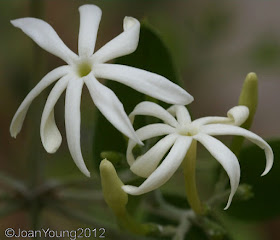Family Oleacae
This is a very rewarding plant with sweetly scented, white, waxy flowers displayed against glossy, dark green foliage. Consider it a 'must-have' in every garden.
If encouraged, it will climb up to 3 m, although not very strongly and is best used as a shrub of up to 1.5 m high. It is medium to fast growing.
The relatively large (40 mm across) flowers are borne in profusion from early spring to summer, August to January. They have a delicate perfume during the day that becomes markedly stronger in the evening and at night.The plant is able to withstand some frost but in colder areas it will need a protected corner, generally it does best in regions that have milder winters. Once established, it is fairly drought tolerant although it will require some additional watering during extended dry spells.
Not all jasmines are scented, though their scent is their biggest attraction and the reason why they are such a popular group of plants.
The flowers attract insects to the garden, and therefore insectivorous birds follow.
Fruits are eaten by birds, and by people in times of famine. Plants are browsed by game. Larvae of the Cambridge Vagrant Butterfly, the Variable Prince Moth, Oleander Hawk Moth, Death's Head Hawk Moth, and King Monkey Moth feed on Jasminum species. Hawk moths pollinate the flowers.
Used traditionally as a love charm and to make a herbal tea, fragrance baths and pot-pourri, the genus is important for its horticultural value as lovely well-known ornamentals and popular garden plants. Sprigs of this jasmine are delightful in flower arrangements as the buds will still open after they are picked and their scent pervades the house.The well-known perfume associated with jasmine is extracted from a species native to Iran, Jasminum officinale.





